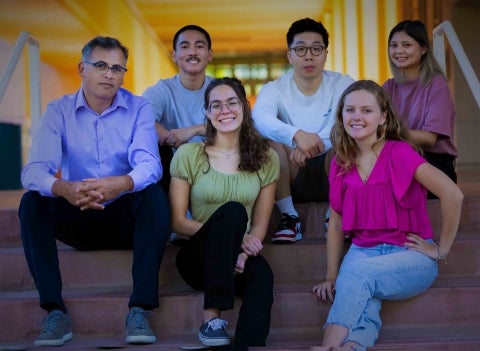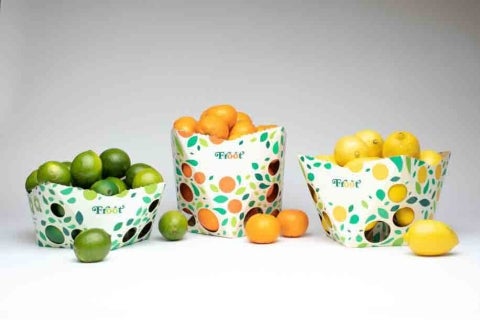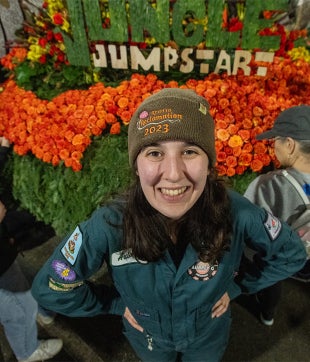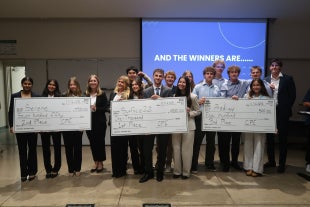Inspired by Beer Bottle Carriers, a Multi-Purpose, Sustainable Fruit Package Designed by Cal Poly Students Earns Recognition During Competitions Aimed at Reducing Plastics
Contact: Pat Pemberton
805-235-0555; ppembert@calpoly.edu
Project aligns with state law requiring all packaging to be recyclable or compostable by 2032
SAN LUIS OBISPO — After setting out to design a sustainable package for produce, a team of Cal Poly students looked to other products — including beer carriers — for inspiration for a design that earned second place in an international packaging competition.

“Once we decided on a product, we started the process of creating prototypes and built about 10 to 15 completely different ideas before we found the right structure,” said team member Heather Lopez, an Industrial Technology and Packaging (ITP) student from Anaheim, California. “We drew inspiration from beverage carriers and lunch boxes for the structure, citrus slices and fruit bowls for the shape, and natural and geometric designs for the aesthetics.”
Cal Poly’s Froot team was one of three that advanced to the Paperboard Packaging Alliance finals in Austin, Texas, last fall, ultimately taking second and an invitation to compete at the WorldStar Global Packaging Awards, the most prestigious and important student packaging contest in the globe with competitors from 37 countries. The team received three medals: a silver for second overall among the 440 global competitors; a gold for marketing appeal; and a bronze medal for sustainability.
The team was notified in early January that members are invited to a gala in Dusseldorf, Germany, on May 6 to receive the medals.
The Paperboard Packaging Alliance, a joint initiative of the American Forest and Paper Association and the Paperboard Packaging Council, works to promote the benefits of paperboard packaging and products in packaging design and selection.
The WorldStar Student Design Challenge continued the goal of increasing sustainability and recyclability. Participants were asked to design new paperboard packaging and components for an existing product that is currently packaged primarily in plastic. The project, which began last winter, was especially timely, since just months before California Gov. Gavin Newsom had signed SB 54 into law requiring all packaging in the Golden State to be recyclable or compostable by 2032, cutting plastic packaging by 25 percent in 10 years and requiring 65 percent of all single-use plastic packaging to be recycled in the same timeframe.
The Cal Poly team — a collaboration between Fiber-Based Packaging, an ITP class, and Graphic Design III, from the Art and Design Department — looked at fruits and vegetables, which are often prepackaged in mesh bags and plastic containers that can’t be recycled.
“Those will end up most likely in landfills,” said Javier de la Fuente, one of the team’s faculty advisors and chair of the ITP area in the university’s Orfalea College of Business.
The Froot team initially focused on mandarins, then limes and lemons. The packages entailed structural and graphic designs, so sub-teams were formed for each focus.

Ultimately, Lopez sketched out a design that combined several ideas, including a distorted cube shape and a recessed handle. The package features colorful, welcoming graphics and holes so customers can see the fruit inside. Meanwhile, the structure, completely recyclable, was designed to be stackable, easy to carry, usable as a bowl upon purchase.
“It was important to our team that Froot appealed to all of its audiences —whether that be the person that shipped the flats, the person that filled the package with fruit, the person that displayed the product on the grocery store shelves, or the consumer that would be bringing Froot home with them,” said Thucmy Dang, an engineering/industrial management graduate student from San Jose, California. “We wanted to create something functional, something that stood out on a shelf, and something that would be environmentally friendly.”
There were other specific considerations, such as a structure design that allowed it to be flattened for easy shipment. The package had to be original, practical and, of course, sustainable.
“Because our project was intended to be marketable to industry professionals, we had to consider the production of our package, such as the cost, materials and shipment, which opened my eyes to the importance and the complexity of sustainability,” Lopez said. “It helped me realize that while phasing out single-use plastic packaging might seem like the answer to all our problems, there’s so much more to consider than just getting rid of plastic when its barrier properties are unnecessary.”
The other members of the team are: Colter Pruyn (consumer packaging) of Park City, Utah, along with graphic design students Han Wong of Atascadero, California, San Jose’s Fred Pastrana, and Hannah Kraus of San Clemente, California. Other faculty advisors included Irene Carbonell (ITP) and Linh Dao (Art and Design).


